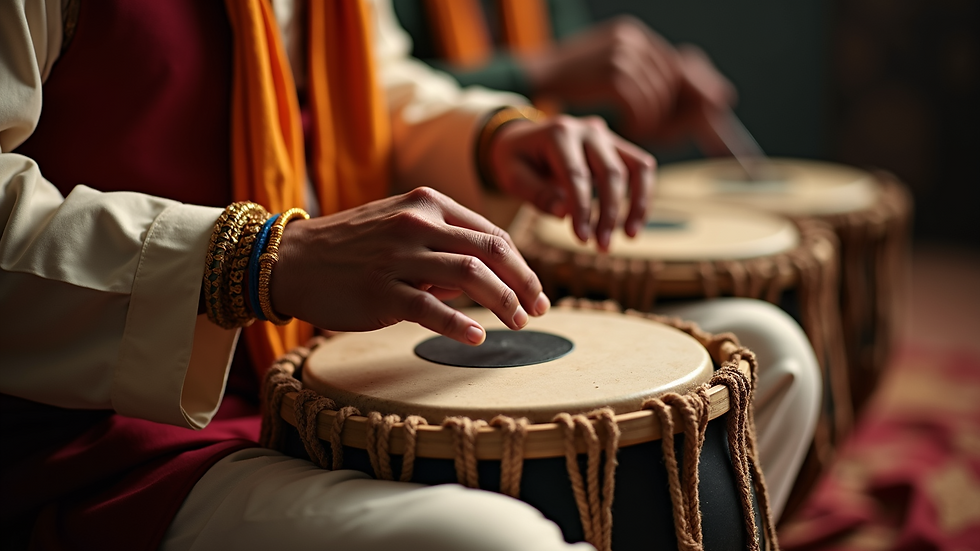Explore the Benefits of Dhrupad Music Therapy
- Sunny Sandhu
- Oct 7
- 4 min read
Music has always been a profound force in human culture, transcending language and geography. But beyond entertainment, music holds a deeper potential - healing. Among the ancient traditions, Dhrupad stands out as a powerful form of sound therapy. Have you ever wondered how the vibrations of sound can influence your mind and body? What if a centuries-old Indian musical form could guide you toward holistic well-being? Today, I invite you to explore the benefits of music therapy through the lens of Dhrupad, a tradition that resonates with the soul and nurtures health.
The Benefits of Music Therapy: More Than Just Sound
Music therapy is not merely about listening to melodies; it is a deliberate, therapeutic use of sound to improve mental, emotional, and physical health. Scientific studies have shown that music can reduce stress, alleviate pain, and enhance cognitive function. But what makes music therapy truly remarkable is its ability to connect with the listener on a profound level.
Stress Reduction: Music slows the pulse and heart rate, lowers blood pressure, and decreases levels of stress hormones.
Emotional Healing: It helps express feelings that are hard to verbalize, providing a safe outlet for emotions.
Improved Sleep: Calming music can improve sleep quality by relaxing the nervous system.
Enhanced Focus and Memory: Certain rhythms and melodies stimulate brain areas responsible for memory and attention.
Imagine a therapy that combines these benefits with the spiritual depth of an ancient tradition. This is where Dhrupad music therapy shines.

The Unique Healing Power of Dhrupad
Dhrupad is one of the oldest forms of North Indian classical music, characterized by its meditative and deeply spiritual nature. Unlike other musical styles, Dhrupad emphasizes the purity of sound and the slow unfolding of ragas (melodic frameworks). This deliberate pace allows listeners to enter a state of deep relaxation and mindfulness.
Why does Dhrupad have such a profound effect? It is because the music is designed to align with the natural rhythms of the body and mind. The sustained notes and precise intonation create vibrations that resonate with the chakras, or energy centers, promoting balance and healing.
Incorporating dhrupad music therapy into your wellness routine can:
Enhance mental clarity and emotional stability.
Promote a sense of inner peace and spiritual connection.
Support physical healing by reducing tension and improving circulation.
This therapy is not just about listening; it is an immersive experience that invites you to participate in the sound, breathing with the music, and allowing it to transform your state of being.
What are the 4 Types of Music Therapy?
Music therapy is a diverse field with various approaches tailored to different needs. Understanding these types can help you choose the right path for your well-being:
Receptive Music Therapy
This involves listening to live or recorded music to evoke relaxation, reflection, or emotional release. It is often used for stress reduction and pain management.
Active Music Therapy
Participants engage in creating music through singing, playing instruments, or composing. This active involvement fosters self-expression and social connection.
Improvisational Music Therapy
This spontaneous form encourages free musical expression without predefined structure, helping individuals explore emotions and creativity.
Analytical Music Therapy
Combining music with psychotherapy, this approach uses music to access unconscious thoughts and feelings, facilitating deep psychological healing.
Each type offers unique benefits, but the meditative and structured nature of Dhrupad aligns closely with receptive and analytical music therapy, making it a powerful tool for holistic healing.

Practical Ways to Integrate Dhrupad Music Therapy into Your Life
You might be wondering how to experience the benefits of Dhrupad music therapy in your daily routine. Here are some actionable steps:
Attend Live Sessions or Workshops
Seek out places like L'Atelier Om on the Côte d'Azur, where traditional Dhrupad and Ayurveda are taught and practiced. Immersing yourself in live music deepens the therapeutic effect.
Create a Dedicated Listening Space
Designate a quiet corner in your home for listening to Dhrupad recordings. Use comfortable seating, dim lighting, and minimal distractions to enhance focus.
Practice Mindful Listening
While listening, close your eyes and breathe deeply. Let the sound waves wash over you, noticing how your body and mind respond.
Combine with Breathwork or Meditation
Pair Dhrupad music with pranayama (breath control) or meditation to amplify relaxation and spiritual connection.
Explore Learning the Art
If you feel drawn, consider learning to sing or play Dhrupad. The discipline and focus required can be a form of moving meditation.
By integrating these practices, you invite a holistic approach to well-being that honors ancient wisdom and modern needs.
Embracing a Holistic Path to Well-Being
The journey toward holistic health is not a sprint but a mindful walk. Dhrupad music therapy offers a unique bridge between tradition and contemporary wellness. It reminds us that healing is not just physical but also emotional, mental, and spiritual.
As you explore this path, ask yourself:
How does sound influence my mood and energy?
Can I create moments of stillness and presence through music?
What ancient practices can enrich my modern life?
The benefits of music therapy, especially through the profound vibrations of Dhrupad, are waiting to be discovered. They invite us to listen deeply - not just to music, but to ourselves.

In embracing these ancient sounds, we open doors to healing that resonate far beyond the ear. The time to experience this transformative power is now.






Comments